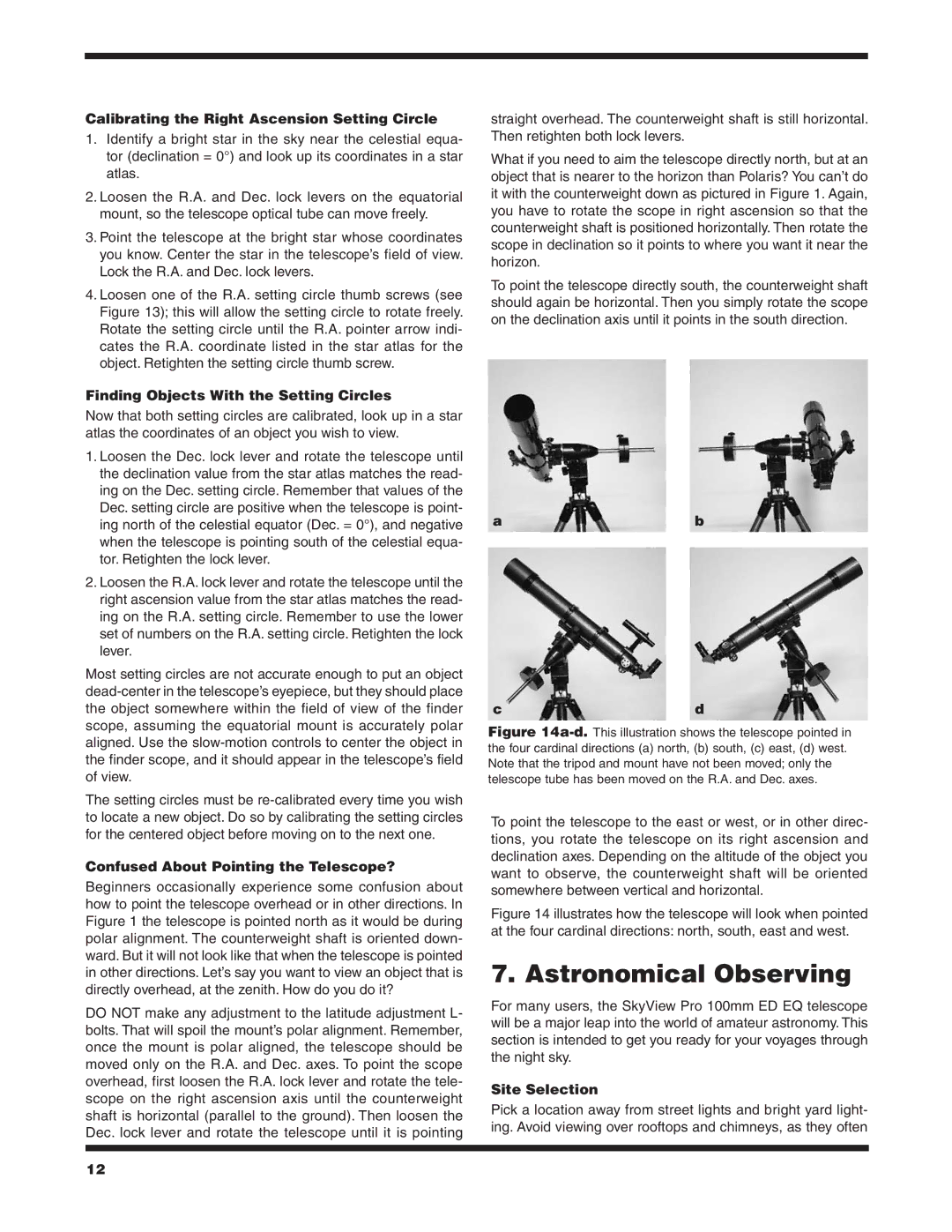
Calibrating the Right Ascension Setting Circle
1.Identify a bright star in the sky near the celestial equa- tor (declination = 0°) and look up its coordinates in a star atlas.
2.Loosen the R.A. and Dec. lock levers on the equatorial mount, so the telescope optical tube can move freely.
3.Point the telescope at the bright star whose coordinates you know. Center the star in the telescope’s field of view. Lock the R.A. and Dec. lock levers.
4.Loosen one of the R.A. setting circle thumb screws (see Figure 13); this will allow the setting circle to rotate freely. Rotate the setting circle until the R.A. pointer arrow indi- cates the R.A. coordinate listed in the star atlas for the object. Retighten the setting circle thumb screw.
Finding Objects With the Setting Circles
Now that both setting circles are calibrated, look up in a star atlas the coordinates of an object you wish to view.
1.Loosen the Dec. lock lever and rotate the telescope until the declination value from the star atlas matches the read- ing on the Dec. setting circle. Remember that values of the Dec. setting circle are positive when the telescope is point- ing north of the celestial equator (Dec. = 0°), and negative when the telescope is pointing south of the celestial equa- tor. Retighten the lock lever.
2.Loosen the R.A. lock lever and rotate the telescope until the right ascension value from the star atlas matches the read- ing on the R.A. setting circle. Remember to use the lower set of numbers on the R.A. setting circle. Retighten the lock lever.
Most setting circles are not accurate enough to put an object
The setting circles must be
Confused About Pointing the Telescope?
Beginners occasionally experience some confusion about how to point the telescope overhead or in other directions. In Figure 1 the telescope is pointed north as it would be during polar alignment. The counterweight shaft is oriented down- ward. But it will not look like that when the telescope is pointed in other directions. Let’s say you want to view an object that is directly overhead, at the zenith. How do you do it?
DO NOT make any adjustment to the latitude adjustment L- bolts. That will spoil the mount’s polar alignment. Remember, once the mount is polar aligned, the telescope should be moved only on the R.A. and Dec. axes. To point the scope overhead, first loosen the R.A. lock lever and rotate the tele- scope on the right ascension axis until the counterweight shaft is horizontal (parallel to the ground). Then loosen the Dec. lock lever and rotate the telescope until it is pointing
straight overhead. The counterweight shaft is still horizontal. Then retighten both lock levers.
What if you need to aim the telescope directly north, but at an object that is nearer to the horizon than Polaris? You can’t do it with the counterweight down as pictured in Figure 1. Again, you have to rotate the scope in right ascension so that the counterweight shaft is positioned horizontally. Then rotate the scope in declination so it points to where you want it near the horizon.
To point the telescope directly south, the counterweight shaft should again be horizontal. Then you simply rotate the scope on the declination axis until it points in the south direction.
ab
cd
Figure 14a-d. This illustration shows the telescope pointed in the four cardinal directions (a) north, (b) south, (c) east, (d) west. Note that the tripod and mount have not been moved; only the telescope tube has been moved on the R.A. and Dec. axes.
To point the telescope to the east or west, or in other direc- tions, you rotate the telescope on its right ascension and declination axes. Depending on the altitude of the object you want to observe, the counterweight shaft will be oriented somewhere between vertical and horizontal.
Figure 14 illustrates how the telescope will look when pointed at the four cardinal directions: north, south, east and west.
7. Astronomical Observing
For many users, the SkyView Pro 100mm ED EQ telescope will be a major leap into the world of amateur astronomy. This section is intended to get you ready for your voyages through the night sky.
Site Selection
Pick a location away from street lights and bright yard light- ing. Avoid viewing over rooftops and chimneys, as they often
12
